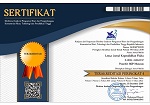The Effect of Mind Mapping Media toward Physics Concepts Understanding
DOI:
https://doi.org/10.33394/j-lkf.v7i1.1903Keywords:
Learning media, Mind Mapping, Concepts UnderstandingAbstract
Science learning carried out by teachers mostly uses conventional methods and rarely uses media in the activities of their teaching and learning process. Media mind mapping in physics learning can be used to describe a lot of material and can package it to be more interesting. The aim of this research to determine the effect of mind mapping media toward the students’ concept understanding. This study used quasi-experimental research with pretest and posttest control group design. The population used was all students of class X in SMA Negeri 1 Lingsar at 2018/2019 Academic Year. The number of samples are 32 students for the experiment class and 33 students for the control class taken by purposive sampling technique. Data analysis technique used is the t-test using IBM SPSS Statistics 22. Based on the results of hypothesis testing (t test), it is known that the significance value of the posttest data (0.00) is smaller than alpha testing (0.05), so it can be stated that the mind mapping learning method influences the students' understanding of concepts.References
Berns, G. R & Erickson, M. P. (2001). Contextual Teaching and Learning: Preparing Students for the New Economy. The Higlight Zone. [Online]. Avelaible on: www.nccte.com
Buzan, T. (2005). Brain Child: Cara Pintar Membuat Anak Jadi Pintar. Jakarta: Gramedia.
Crandramica, F. (2017). Pengaruh Penerapan Model Pembelajaran Mind Mapping Terhadap hasil Belajar IPS pada Siswa Kelas IV SD Negeri 2 Gunung Terang Bandar Lampung TP 2016/ 2017.Skripsi tidak diterbitkan. Universitas Lampung.
Hermawan, H., A. (2016). Metode Penelitian Pendidikan Sekolah. Bandung: UPI PRESS.
Heruman. (2008). Model Pembelajaran Matematika di Sekolah Dasar. Bandung: PT Remaja Rosdakarya.
Pujianto & Suyoso. (2011). Analisis Kecenderungan dan Tren Penelitian Pada Mahasiswa pendidikan Fisika Sebagai Revitalisasi Bidang Keahlian Penunjang Akreditasi Yogyakarta: Graha Ilmu.
Simanjuntak, M. P. (2013). Interaksi Model Pembelajaran kooperatif Tipe NHT Terhadap Hasil Belajar Siswa SMP pada Materi Gaya dan Hukum Newton T.P 2012/2013. Jurnal INPAFI, 1(2), 107-113.
Sugiyono. (2012). Metode Penelitian Pendidikan Pendekatan Kualitatif, Kuantitatif, R & D. Bandung: Alfabeta.
Tambunan, D. S. & Siregar, A. M. (2014). Pengaruh Model Pembelajaran Berbasis Masalah dengan Menggunakan Media Kartun Terhadap Hasil Belajar Siswa pada Materi Gaya dan Hukum Newton di Kelas VIII SMP Swasta An-Nizam Medan Tahun Pelajaran 2013/2014. Jurnal INPAFI, 2(3), 28-37.
Rahayu, R., T. (2014). Meningkatan Daya Ingat Siswa Melalui Penggunaan Media Mind Mapping Pada siswa. Yogyakarta: Universitas Negri Yogyakarta
Syahidah, N. (2015). Metode Pembelajaran Mind Mapping Sebagai Upaya Mengembangkan Kreativitas Siswa Dalam Pembelajaran Ekonomi. Prosiding Seminar Nasional Pendidikan Ekonomi FE UNY "Profesionalisme Pendidik dalam Dinamika Kurikulum Pendidikan di Indonesia pada Era MEA".
Downloads
Published
How to Cite
Issue
Section
License
Authors who publish with Lensa: Jurnal Kependidikan Fisika agree to the following terms:
- For all articles published in Lensa: Jurnal Kependidikan Fisika, copyright is retained by the authors. Authors give permission to the publisher to announce the work with conditions. When the manuscript is accepted for publication, the authors agree to automatic transfer of the publishing right to the publisher.
- Authors retain copyright and grant the journal right of first publication with the work simultaneously licensed under a Creative Commons Attribution-ShareAlike 4.0 International License that allows others to share the work with an acknowledgment of the work's authorship and initial publication in this journal.
- Authors are able to enter into separate, additional contractual arrangements for the non-exclusive distribution of the journal's published version of the work (e.g., post it to an institutional repository or publish it in a book), with an acknowledgment of its initial publication in this journal.
- Authors are permitted and encouraged to post their work online (e.g., in institutional repositories or on their website) prior to and during the submission process, as it can lead to productive exchanges, as well as earlier and greater citation of published work (See The Effect of Open Access).

This work is licensed under a Creative Commons Attribution-ShareAlike 4.0 International License.



